Tursunzoda
Tursunzoda (Tajik: Турсунзода, also Tursunzade from Russian spelling) is a city in western Tajikistan, known for its aluminium smelting plant TadAZ. It is located 60 km west of Dushanbe (40 km west of Hisor), near the border with Uzbekistan. It is near several rivers, Shirkent and Karatag immediately to the west and east of the city, and Kofarnihon further east. Its population was given as 40,600 in the 1989 census, falling to 39,000 in 2000, and estimated at 37,000 in 2006.
- See also Tursunzoda district
Tursunzoda | |
|---|---|
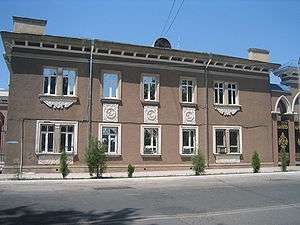 Tursunzoda Government House | |
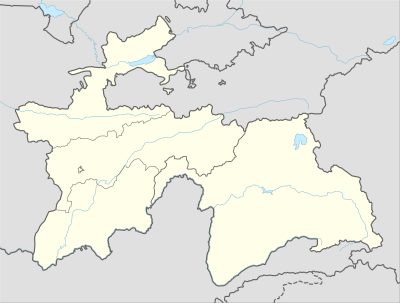 Tursunzoda Location in Tajikistan | |
| Coordinates: 38°30′N 68°13′E | |
| Country | |
| Province | Region of Republican Subordination |
| Population (2019)[1] | |
| • Total | 53,700 |
| Website | http://regar.tj |
The city has two television stations, TV-REGAR and TV-TADAZ, two newspapers, Aluminiy Tojikiston and Regar, and a radio station.
Tursunzoda is home to football club Regar-TadAZ Tursunzoda.
History
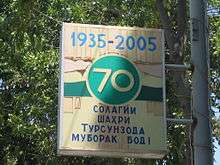
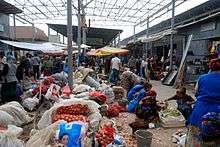
Tursunzoda was originally the village of Regar, meaning "a town on sand". In 1978, the town and with it the whole district were renamed in honor of the Tajik national poet, Mirzo Tursunzoda. Its railroad station is still called Regar. The city developed from a village as a regional centre for an agricultural district in the western part of Gissar (Hisor) Valley. Fruits, especially grapefruit, vegetables, and cotton are grown in the district. Thanks to plentiful irrigation from the local rivers, Tursunzoda district is a major rice-growing region, producing 1,400 tons, or 13% of Tajikistan's rice harvest in 2006.[2] In the 1960s, the nearby Nurek Dam hydroelectric power station on the Vakhsh River made the city a good location for industry, and besides the aluminium plant, there are also china, brick, cable, and cotton cleaning plants.
Aluminium plant
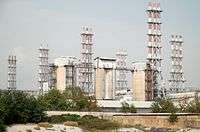
The Tajik aluminium smelting plant, TadAZ, in Tursunzoda, is the largest aluminium manufacturing plant in Central Asia, and possibly the world, and Tajikistan's chief industrial asset. The country has no native aluminium ore, so the raw material for the plant has to be imported. Construction of the plant proper began in 1972, and the first pouring of aluminium took place on March 31, 1975. It consumes 40% of the country's electrical power, and a 2002 study found it responsible for notable fluorine water pollution in the region and air pollution.
Notes
- "Population size, Republic of Tajikistan on January 1, 2019" (PDF) (in Tajik). Tajikistan Statistics Agency. 2019. p. 27. Retrieved 28 March 2020.
- Agriculture in Tajikistan, statistical yearbook, Dushanbe, 2007, p. 87.
References
| Wikimedia Commons has media related to Tursunzoda. |
- Tursunzade School 101 Web site of a Tursunzade school, provided by Relief International - Schools Online.
- Country Analysis : Tajikistan Originally from the Department of Energy site, now hosted by NIGC.org.
- Biosphere to Clean Up Water in Tajikistan Report by the Virtual Foundation
- "Tursunzade", Encyclopædia Britannica
- World Gazetteer: Tursunzoda at Archive.today (archived 2012-12-08) Including census figures